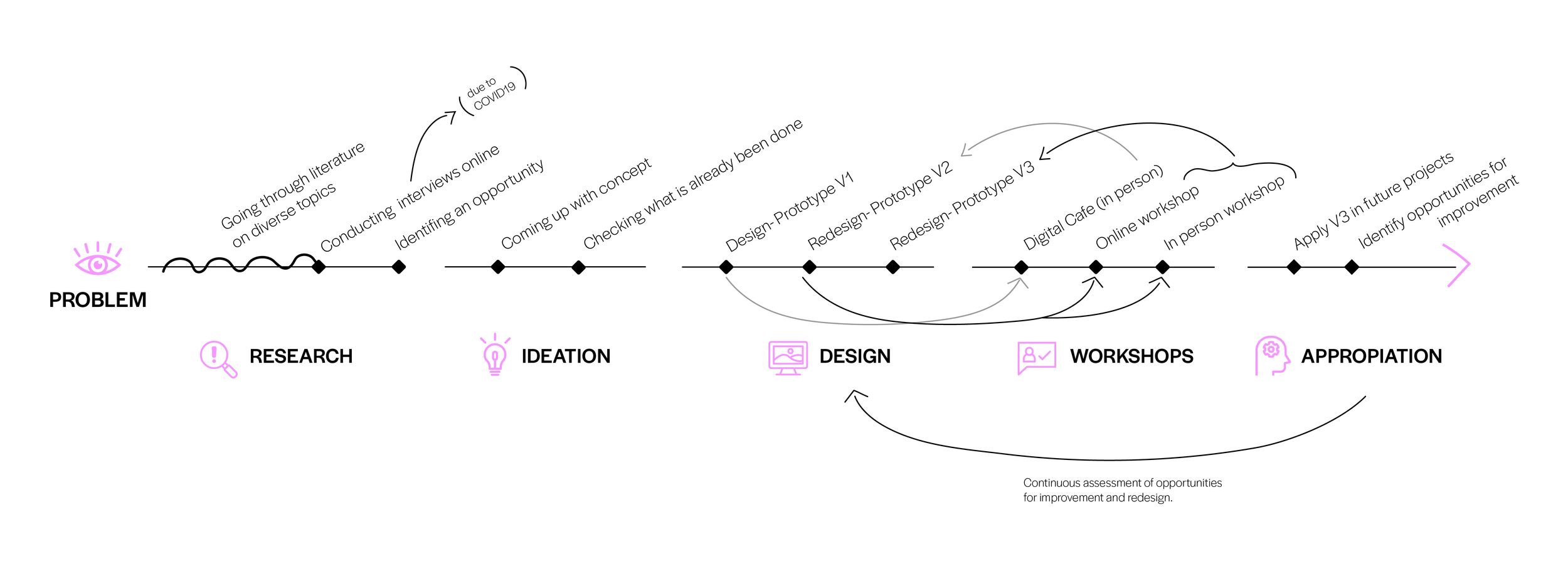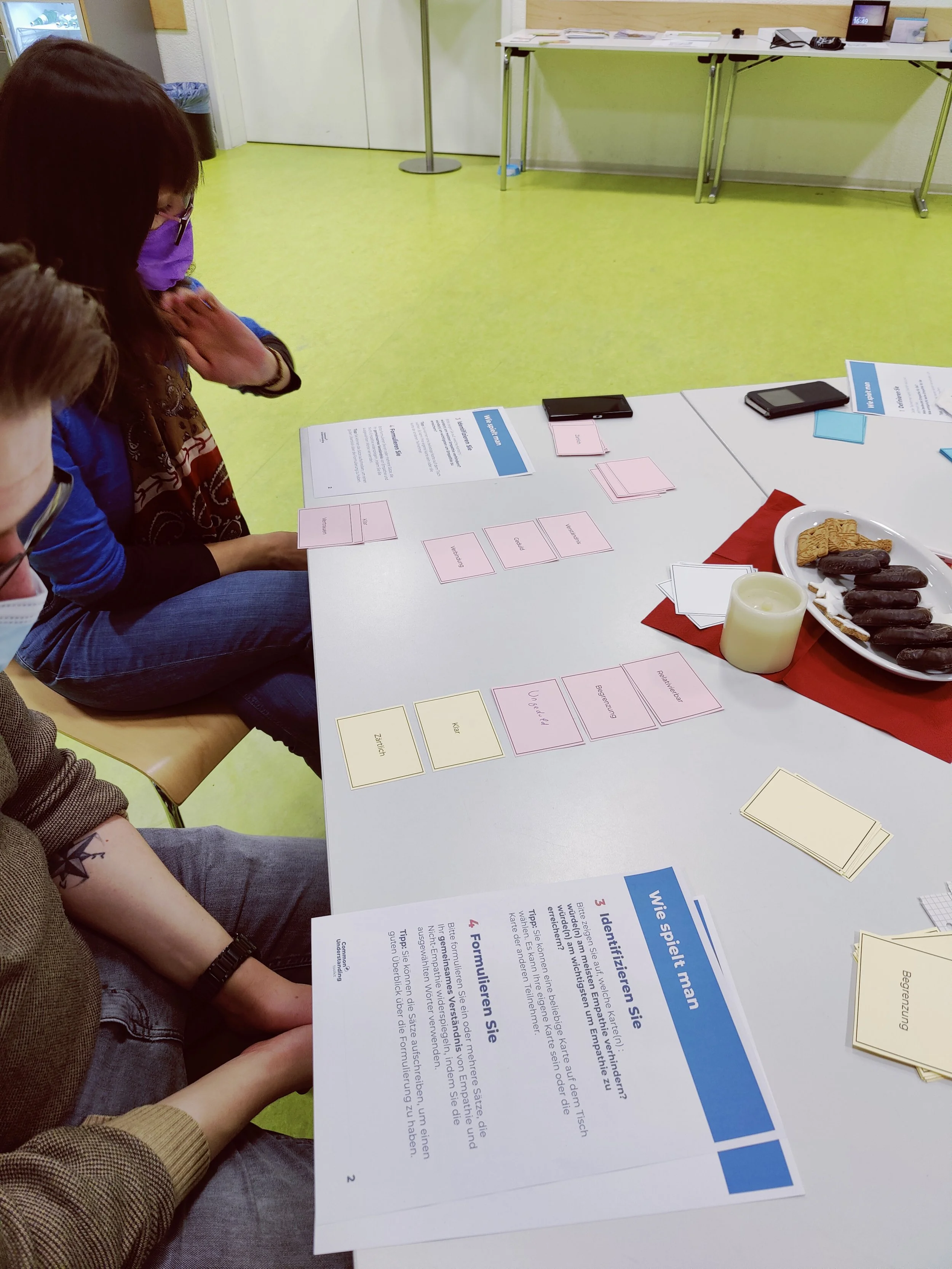
Common Understanding Toolkit
Co-creating a shared understanding of empathy in design practices
USER RESEARCH | USER EXPERIENCE | RESEARCH METHODS
Designers seek different tools that help them build empathy toward users and create impactful solutions. Empathy-building can be challenging when working with user groups such as older adults because they may be difficult to relate to, and some commonly used tools can result in stereotypical user characteristics. Hence, developing an active user-practioner relationship becomes essential.
To foster empathy-building between users and practitioners during design processes, we embarked on a research initiative to find effective solutions for this challenge.
The Common Understanding Toolkit consists of a set of card activities, that intends to motivate dialogue between older adults and designers, explore the differences and similarities shared, and encourage co-creating an understanding of the meaning of empathy that could be carried across the design practice.
The project’s process
RESEARCH
We began by conducting a literature review on the topic of empathy, its approaches within the field of HCI, and empathy-building in the design process.
Conducting interviews online
So, what did we learn?
We conducted semi-structured interviews with older adults and researchers to further investigate these different perspectives on fostering empathy. Due to the COVID-19 pandemic, these interviews were conducted virtually via Zoom with volunteer participants from Germany and Costa Rica.
After receiving the participant's consent, the interviews were recorded to support subsequent data collection processes. Descriptive notes were taken during the interviews to capture key moments and insights. Participants were encouraged to think aloud during the interviews to ensure their interpretations were accurately captured.
After coding the data collected from the interviews, it revealed three main themes:
The user level of technological savviness greatly impacts the way they approach technology.
Researchers and older adults had difficulty describing empathy. Participants used a range of heterogeneous vocabulary to define empathy, such as connection, trust, honesty, understanding, patience, and repetition.
There are varying notions of what makes users feel comfortable while using technology.
Topics and relationships found during literature analysis
IDEATION & DESIGN
Taking into consideration the mentioned discoveries and using Design Thinking, the ideation phase started with a brainstorming session. From this exercise, it was determined to create a series of activities using cards that would motivate a conversation between designers and older adults about the meaning of empathy.
The set of activities was named “The Common Understanding Toolkit.” It consisted of a deck of 24 cards, each with a word extracted from the participants' vocabulary to describe empathy during the interviews. Additionally, blank cards were added to allow the participants to add other vocabulary.
Moreover, the toolkit included four different activities: Define, Build, Identify, and Formulate, all of which are described in an instruction manual.
The first activity Define consists of determining an individual vocabulary and meaning around the term empathy. This, by choosing three cards to describe “What is empathy? and the other three for What is not empathy? In the next activity Build, the participants are meant to construct a common definition of the term through discussion and negotiation, to describe empathy and not empathy. In the third exercise Identify, each participant chooses from the selected cards, what considers to be the most challenging one to accomplish empathy. Lastly, the participants Formulate together a phrase that reflects a common understanding of empathy using the chosen vocabulary
Coming up with a concept
WORKSHOPS
To test the toolkit, a series of unmoderated sessions were organized. An alpha prototype was created using Figma, which included cards and instructions and was prepared in German, English, and Spanish. Participants were observed during the sessions, and interactions were documented through notes, videos, and pictures. Prior to each session, participants were asked for their consent for data collection.
A total of three workshops were conducted. The first session was conducted in Spanish via Zoom with an older adult and a researcher in Costa Rica.
The third workshop was conducted during "Digital Cafe" sessions with older adults at a community center in Siegen, Germany. The Digital Cafe is a secure space where older adults can test new digital tools and ask volunteers questions about them. During the session, the workshop was conducted as a group, with two older adults and two volunteers using the German version of the toolkit
The second session was conducted in English in Germany with two HCI master's students with research experience.
Digital Cafe workshop
Workshop conducted online
APPROPIATION
After analyzing the data collected from the workshops, we identified common themes and opportunities for improvement for a future beta version:
Formalize the language format in the cards. The alpha prototype's vocabulary was extracted from participant interviews, resulting in varied wording, including verbs in different tenses, nouns, and short sentences such as "Relate to each other" or "Being approachable."
Reconsider the number of cards per deck. The alpha prototype had 24 cards with different wording and six blank cards. Many participants felt that there were too many cards, and our observation of the cards discussed during the sessions suggests reducing the number to 14-16 cards depending on the language.
Participants used the provided blank cards to add their own words in all sessions. This ownership suggests that the given vocabulary worked as a prompt for new vocabulary, which can be further explored in the next version of the toolkit.
Formulate: the last activity appeared to be the most challenging. During the first set of workshops, the pairs wrote down the shared understanding of empathy, with one participant taking the lead in writing. However, in the group session, the discussion and negotiations took most of the time, and the participants decided collectively to skip this last step.
We believe that the findings and reflections from this project will encourage HCI practitioners to discuss how we empathize with our target users in the design practice and its impact on the design of digital artifacts. This is especially relevant for user groups such as older adults who may feel isolated in our fast-paced digital society.
Redesign- Prototype V3 instructions
Redesign- Prototype V3 cards










